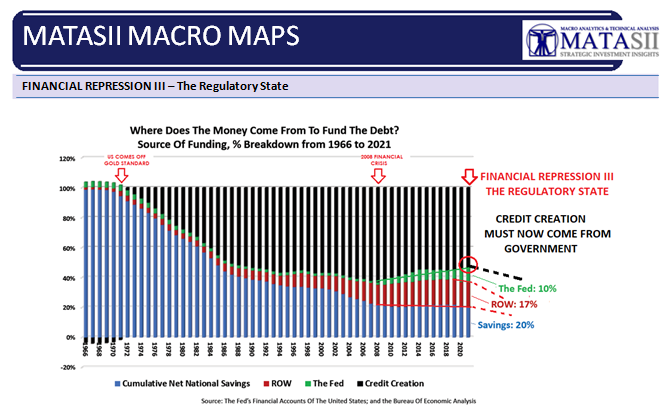TIPPING POINTS
MARKET RISK
THE DE-STABILIZING FISCAL SHOCK WAVE NOW KICKING IN
The spending and public policies implemented under the auspices of a Coivd-19 recovery are only now being felt. Rather than achieving their intended purpose, they are resulting in a de-stabilizing shock to the global economy. This is initially being felt as ending the era of the “Great Moderation” and the beginning of an era, similar to what preceded it, with was marked by higher volatility, high inflation and higher interest rates.
As a direct result we can expect higher risk term premia, higher equity risk premiums, surging US debt financing costs and less available investment capita. All of which will seriously crimp economic growth.
This is highly likely to further the growing adoption of Financial Repression III with an expanding Regulatory State having a broader role in credit creation as well as attempts at supply-side initiatives.
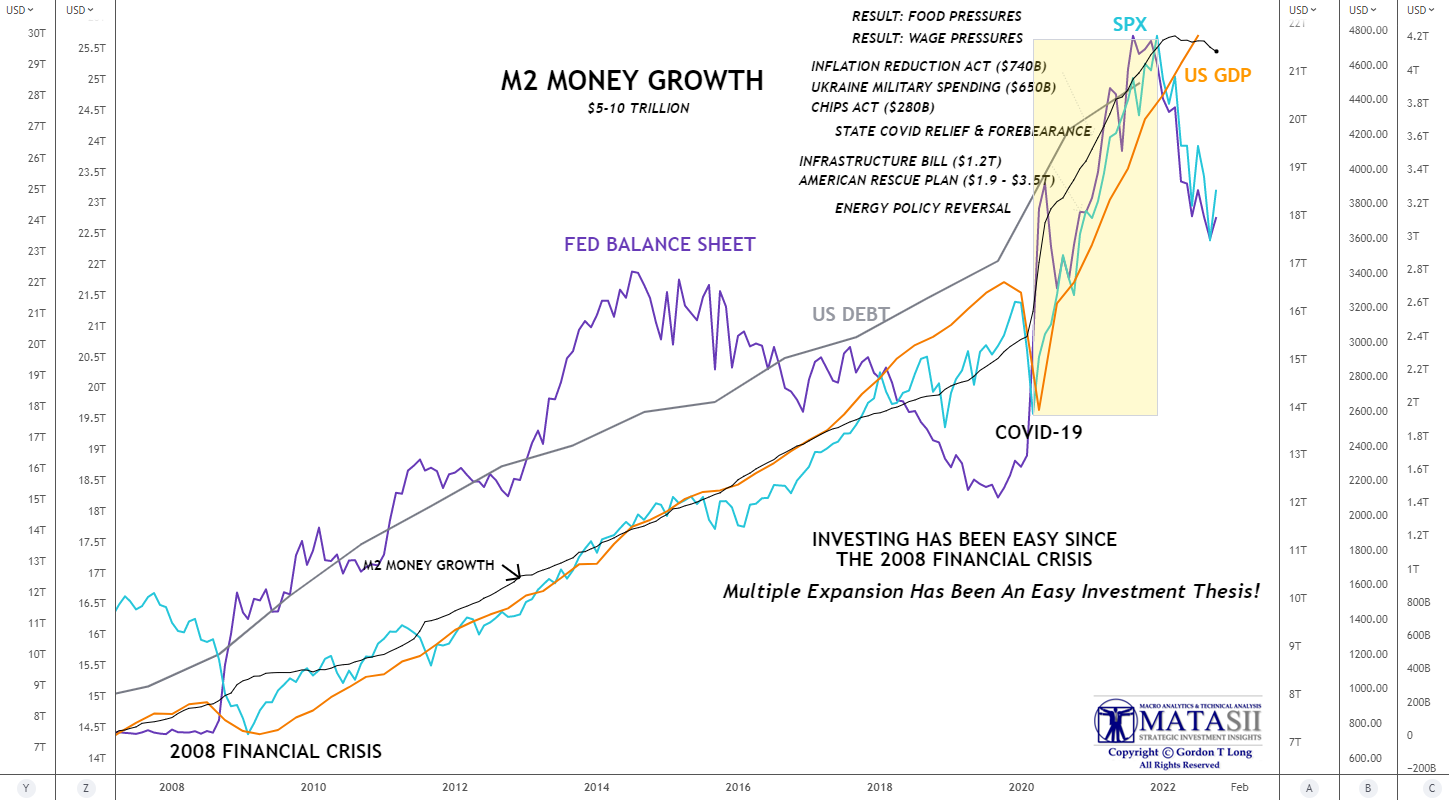 The exploding rate of US Money Growth has effectively created a De-stabilizing Global Shock, that with a lag is only now beginning to be felt! There has not been any year in the past 50 when both the S&P 500 and 10-year Treasuries had negative total returns in the same year, let alone double-digit drops. The combination of this year’s weak equity markets and a deeply inverted yield curve is certainly sending an ominous message for next year’s growth outlook. Despite unprecedented stimulus ($5-$10T in the US alone) we are witnessing global growth fall from 6% in 2021, to just over 3% this year, to estimates of 2.25% in 2023. This should be seen as indicative of the magnitude of what is currently underway!
The exploding rate of US Money Growth has effectively created a De-stabilizing Global Shock, that with a lag is only now beginning to be felt! There has not been any year in the past 50 when both the S&P 500 and 10-year Treasuries had negative total returns in the same year, let alone double-digit drops. The combination of this year’s weak equity markets and a deeply inverted yield curve is certainly sending an ominous message for next year’s growth outlook. Despite unprecedented stimulus ($5-$10T in the US alone) we are witnessing global growth fall from 6% in 2021, to just over 3% this year, to estimates of 2.25% in 2023. This should be seen as indicative of the magnitude of what is currently underway!
WHAT YOU NEED TO KNOW
- THE “GREAT MODERATION’ ERA HAS ENDED
-
- The “Great Moderation” Era that delivered low inflation, moderate growth and historic low interest rates has come to an end.
- INCREASING RISK TERM PREMIUM
-
- The Post Great Moderation era will result in a return to a prior period of bond, equity, currency and credit market volatility, high inflation, higher interest rates and most importantly increased Risk Duration Premia and Equity Risk Premiums.
- GEO-POLITICAL RISK BEING PRICED IN
-
- We’re in a new world order of geopolitical fragmentation, a full break with the post-Cold War era.
- We have been warning about increasing Geo-Political Risk for a few years now in our Thesis Paper 2020 – Global Conflict,Thesis Paper 2018 – New World Order and more recently in our July UnderTheLens video entitled “A Quickly De-Stabilizing World“.
- FINANCIAL REPRESSION III – DEMAND VERSUS SUPPLY
-
- Money Flows Are The New investment Strategy.
- We are moving from a mechanism where bank credit is controlled by interest rates to a Quantitative Mechanism that is Politicized. It is called the Regulatory State.
- Developing approaches:
-
-
- Increasing Government Use of Credit Guarantees,
- Aim for a consistent high Growth Rate of Money (not too high),
- Reinforcement of Regulatory Capture (the “Regulatory State”),
- Engineer Nominal Growth & Inflation Rates > Interest Rates
-
- CONCLUSION
- THE GREAT DE-STABILIZER SHOCK
-
-
- The reaction and policy initiatives taken under the auspices of the impact of Covid-19 has resulted in a Global Shock that is only now being felt as effectively having de-stabilized the global economy.
- The result of this shock will be broad, but highlighted by:
-
-
-
-
- Increased market volatility most critically in Bond and Credit markets resulting in higher risk duration premia for financing and equity risk premium pricing,
- Financial Repression III – The emergence of the Regulatory State to better facilitate credit growth as unencumbered collateral shortages become an increasing problem,
- Growth of Regional Trading Blocs,
- A profound shift to “Near-Shorting”, increasing import barriers and slowing Globalization & trade.
-
-
JP MORGAN: “For countries that see CPI exceed 5%,
it takes around 10 years for CPI to fall back to 2%.”
THE GREAT MODERATION
Academics Jim Stock and Mark Watson coined the term Great Moderation in 2002 to describe the period of steadily lower volatility in inflation and activity. Steadily expanding production capacity and demand shocks were key features of the Great Moderation. Exuberance and borrowing binges drove overheating, while souring sentiment and collapsing spending
drove recessions. Central banks could mitigate both by raising or cutting rates. The policy response did not involve trade-offs; there was no conflict between stabilizing both. This helped spark a bull market in both bonds and equities.
LOW INFLATION – MODERATE GROWTH – HISTORIC LOW INTEREST RATES
The regime of subdued inflation and output volatility is highly likely over! Why?
Amongst a number of reasons, production constraints are now hampering the economy in ways they never did during the Great Moderation. The pandemic triggered a massive sectoral reallocation that has yet to normalize. The key bottleneck has been labor supply, rather than just supply chain disruptions. Many people are hesitant to go back to work or are taking longer to find a job in a new sector. The constraints have only been exacerbated by the Ukraine war’s energy and food price shocks – and are driving inflation. This is likely not to change any time soon.
Two powerful structural trends are driving up production costs and we suspect will only worsen going forward:
-
- The pandemic and Ukraine crisis are accelerating geopolitical fragmentation. Think of ongoing sanctions on Russia, the push for energy security and effort to diversify supply chains. The war is driving factors we have been highlighting for some time now:
- the emergence of new trading and alliance blocs, and
- Increasing U.S.- China disagreements, tension and conflicts.
- The transition to reach net zero carbon emissions by 2050 is likely to create a sectoral shakeout similar to the pandemic. The transition is essentially a handoff from carbon-emitting production methods to zero-carbon ones. This handoff can be expected to be very rough. Carbon intensive production can fall faster than lower-carbon alternatives are phased in. The result: periods of supply shortages and high prices or the carbon-intensive outputs the economy still needs. These imbalances will drive macro volatility and persistent inflation during the emerging Beta Drought Decade which we outlined in a recent video and our 2022 Thesis Paper: SUSTAINABILTY – For Whom?
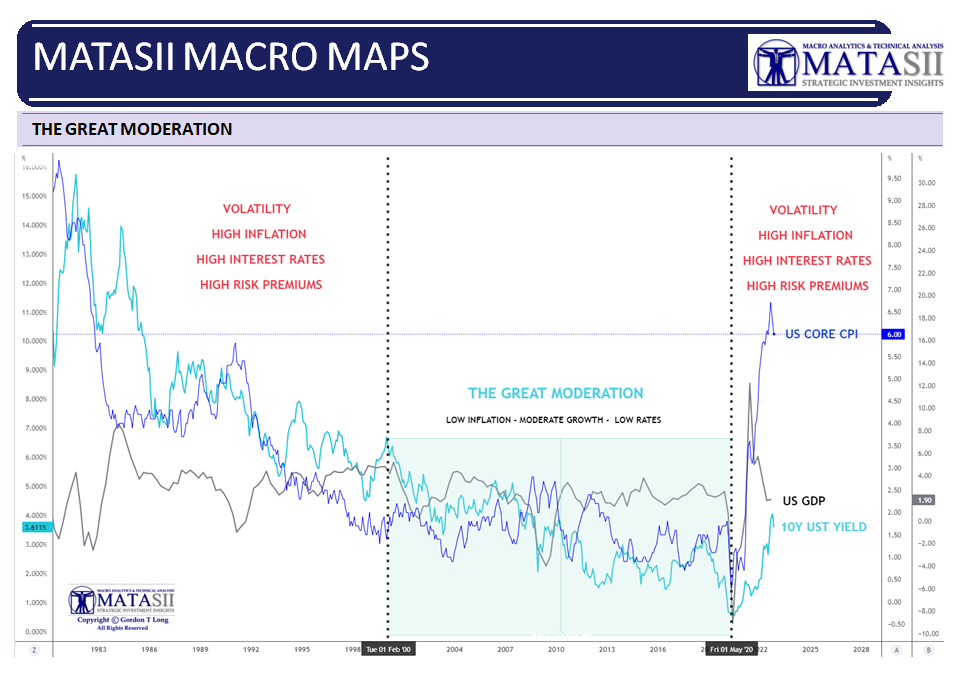
REVERSAL OR REGRESSION?
We are returning to a similar regime we had prior to the Great Moderation. Whether we see it as a reversal or a regression to a more normalized regime time will tell.
VOLATILITY
HIGH INFLATION
HIGH INTEREST RATES
HIGH RISK PREMIUMS
THE POST “GREAT MODERATION” REGIME SHIFT
 A more complex world needs nuanced discussion to find the best solutions. The problem: everything has become politicized – and whoever has the loudest or simplest argument often wins. We believe this is helping bring about the end of the Great Moderation. The political dialogue oversimplifies many topics. This is true for inflation. There is a loud chorus of critics who claim the inflation threat was there for everyone to see: if only central banks had raised rates earlier, we wouldn’t be in this mess. Rather than pushing back on this narrative, central banks have resorted to sounding ever tougher on inflation. They appear to solve for the politics of inflation, not the economics. It is also true for controversial topics like climate change or geopolitics. All this implies that policy trade-offs are now much harder. Central banks are likely to veer between favoring growth over inflation, and vice versa. This will result in persistently higher inflation and shorter economic cycles.
A more complex world needs nuanced discussion to find the best solutions. The problem: everything has become politicized – and whoever has the loudest or simplest argument often wins. We believe this is helping bring about the end of the Great Moderation. The political dialogue oversimplifies many topics. This is true for inflation. There is a loud chorus of critics who claim the inflation threat was there for everyone to see: if only central banks had raised rates earlier, we wouldn’t be in this mess. Rather than pushing back on this narrative, central banks have resorted to sounding ever tougher on inflation. They appear to solve for the politics of inflation, not the economics. It is also true for controversial topics like climate change or geopolitics. All this implies that policy trade-offs are now much harder. Central banks are likely to veer between favoring growth over inflation, and vice versa. This will result in persistently higher inflation and shorter economic cycles.
The end result: higher risk premia across the board.
BOND VOLATILITY RESULTS IN:
- VaR (Value-At-Risk) INCREASING
- RISK PREMIUMS RISING
Unprecedented leverage In this new world shaped by supply will result in trade-offs for policymakers becoming starker – at a time when their maneuvering room has shrunk. Global debt has surged to new highs as governments sought to limit the fallout from the pandemic. This means that small rises in interest rates can have an outsized and painful impact, as the chart shows. The private sector debt is also susceptible to higher rates, especially via housing. All this makes it tougher for central banks to hike rates – and ultimately more tempting to live with inflation.
CHART: ABOVE RIGHT: The sensitivity of high debt levels to higher interest rates makes it harder to contain inflation via rates. Policy trade-offs will be much harder going forward. Central Banks are increasingly likely to veer between favoring activity over inflation. and vice versa. This may result in higher inflation and short cycles.
CHART BELOW: When markets diverge it is normally a sign of underlying, unresolved problems. This can be seen in the iShares 20 Plus Year Treasury Bond ETF (TLT) below. The upper panel shows price. The lower panel shows flows. Normally as flows rise, price rises and yields fall. Normally investors buy bonds for hedging protection, since historically bonds normally rise in price when stocks fall in price. This has been the expected case up until the end of Q1 this year. Then though prices were falling (yields rising), fund flows were surging!
This can logically be attributed to more investors selling their holdings than investors rushing in for needed protection. This completely goes against normal portfolio theory and 60-40 Parity investment funds. Something is seriously broken or minimally we are in the midst of the major regime change. Further proof of this can be seen in the chart near the bottom of this newsletter describing what is occurring regarding the Petrodollar. China and Japan have been unloading their US Treasury holdings in a major way. Additionally, foreign buying of US Treasury bonds has been falling precariously.
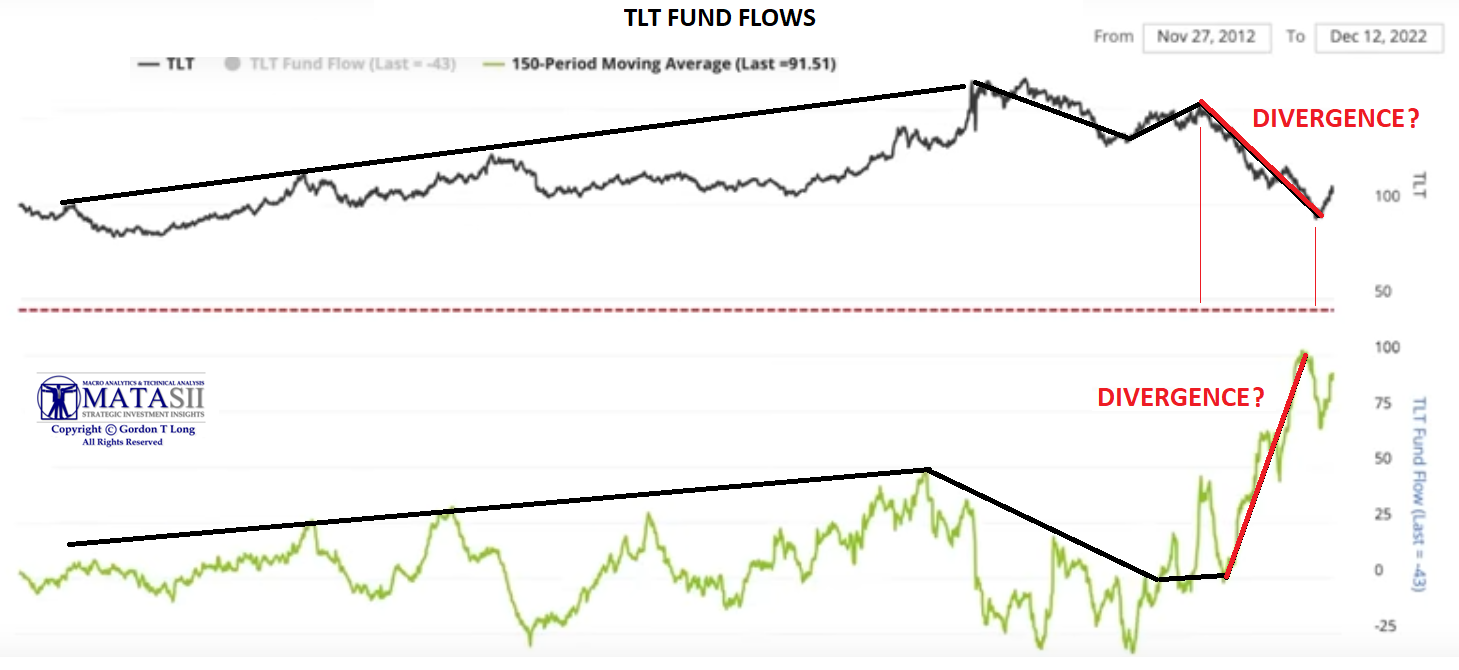
INCREASING RISK TERM PREMIUM
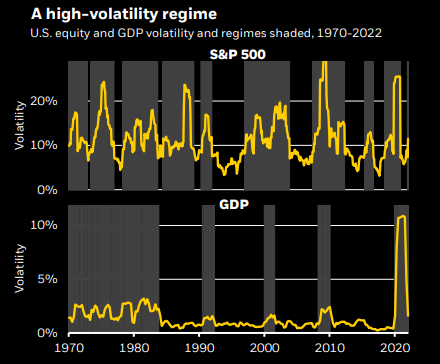 As we mentioned previously, the rewiring of global supply chains and the attempts to transition to net-zero are two central reasons why it is likely to be a more volatile world – and this new regime won’t be temporary! Increased volatility means higher VaR and higher risk term premiums which means higher US debt financing costs.
As we mentioned previously, the rewiring of global supply chains and the attempts to transition to net-zero are two central reasons why it is likely to be a more volatile world – and this new regime won’t be temporary! Increased volatility means higher VaR and higher risk term premiums which means higher US debt financing costs.
CHART RIGHT:
A higher macro volatility regime is typically needed to sustain a higher market volatility regime. We have entered a regime of higher macro and market volatility. This implies that market views may have to change more quickly and get more granular.
CHART BELOW:
The Great Moderation fostered a steady macro backdrop that set the stage for decades-long bull runs for both stocks and bonds. Central banks could soften demand shocks and pump up growth with looser
policy – facing only a modest trade-off of inflation (the green line in the chart).
The end of the Great Moderation means the trade-offs become much starker, as the orange line in the chart shows. The entire curve has shifted and lengthened, magnifying the impact of policy decisions. At one extreme (bottom right), central
banks crush growth to rein in inflation. This raises recession risk and is particularly damaging for equities. That is a 2022 story. At the other extreme, central banks go easy and face the risk of inflation soaring (top left). Bond prices fall as
investors demand a higher term premium. This will be the main conundrum for 2023. Bottom line: Don’t expect a repeat of the Great Moderation’s sustained stock-bond bull markets.
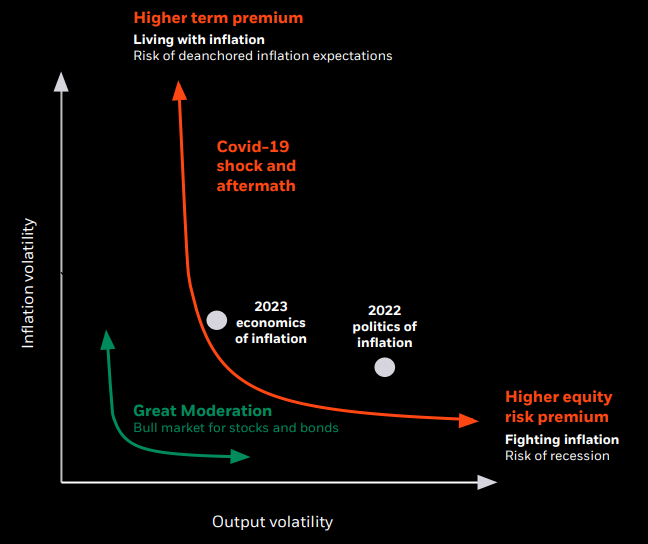
GEO-POLITICAL RISK BEING PRICED IN
We have been warning about increasing Geo-Political Risk for a few years now in our Thesis Paper 2020 – Global Conflict, Thesis Paper 2018 – New World Order and more recently in our July UnderTheLens video entitled “A Quickly De-Stabilizing World“.
We’ve entered into a new world order. This is the most
fraught global environment since World War II – a full break from the post-Cold War era. We see geopolitical cooperation and globalization evolving into a fragmented world with competing blocs. That comes at the cost of
economic efficiency. Sourcing more locally may be costlier for firms, and we could also see fresh mismatches in supply and demand as resources are reallocated.
A prime example is the response to Russia’s invasion of Ukraine. Western sanctions have triggered a pursuit of economic self sufficiency. Energy security is now a priority: As Europe weans itself off Russian oil and gas, we’ve seen
energy shortages and higher prices. In the U.S., we see a push to favor trading partners when sourcing the metals and materials needed in the net-zero transition.
Strategic competition between the U.S. and China has intensified. A tough stance toward China has bipartisan support in Washington. The U.S is trying to restrict China’s
access to high-end technology.
China’s recent party congress was a pivotal event, both politically and economically, in our view. China looks set to de-emphasize economic growth as it pursues self-sufficiency in energy, food and technology. We see slower growth compounded by the effects of an aging population over time. Geopolitical fragmentation is likely to foster a permanent risk premium across asset classes, rather than have only a fleeting effect on markets as in the past. Market attention is likely to stay fixated on geopolitical risks. See the chart. All this will likely contribute to the new regime of greater macro and market volatility – and persistently higher inflation.
We’re in a new world order of
geopolitical fragmentation,
a full break with the post-Cold War era.
|
THESIS PAPER 2020 – GLOBAL CONFLICT |
 |
|
THESIS PAPER 2018 – NEW WORLD ORDER |
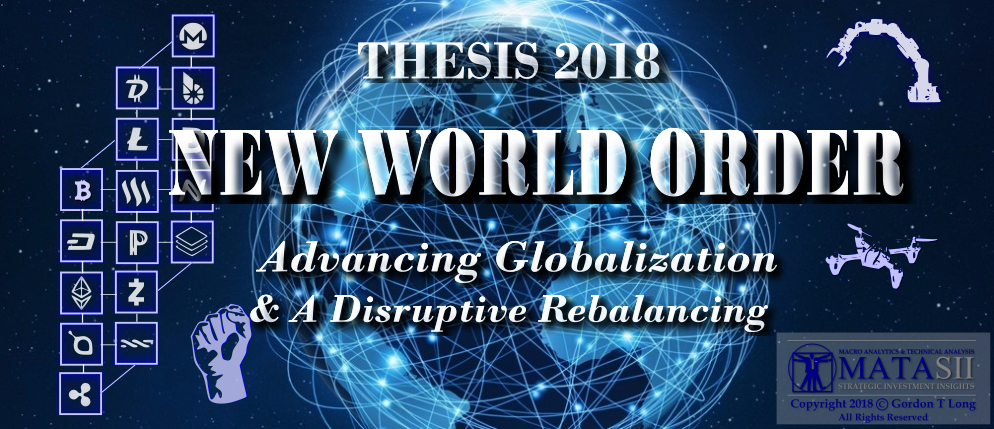 |
|
UnderTheLens – 06 22 22 – JULY – A Quickly De-Stabilizing World |
CHART BELOW: THE BGR INDICATOR
There has been a clear surge in market interest in geopolitical risk based on how fraught the current environment has become. This is the most dangerous environment since WWII or the Cuban Missile Crisis at the height of the Cold War. The world is splitting up into competing blocs which are pursuing self-reliance in the form of a Multi-Polar World versus the Uni-Polar world since WWII.
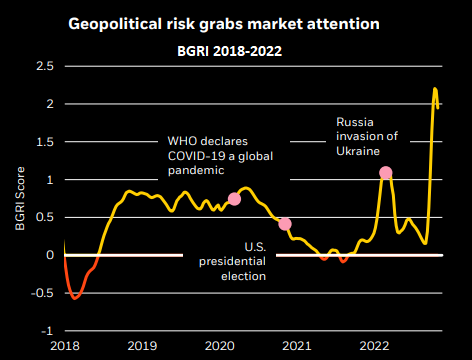
FINANCIAL REPRESSION III
Our recent video on Financial Repression updated the expected regime change (and matching the developments outlined above), which are underway regarding the macroprudential strategy of Financial Repression.
|
UnderTheLens – 11/23/22 – DECEMBER |
 |
|
MARKETS ARE CENTRALLY ABOUT DEMAND/SUPPLY DEMAND PROBLEMS – Central Bank Driven Central Bank Monetary policies primarily address Demand through interest rate doctrine. It has little to no impact on matters of Supply. SUPPLY PROBLEM – Regulatory State Driven The direction of Supply within the private sector are better influenced by taxation, regulatory policy and fiscal spending. These are the purview of the sovereign state. DEVELOPING APPPROACH:
POLITIZATION OF CREDIT Money Flows Are The New Game We are moving from a mechanism where bank credit is controlled by interest rates to a Quantitative Mechanism that is Politicized. It is called the Regulatory State. CHART BELOW: Few Alternatives Remaining! The chart below illustrates the shift from Capitalism to Creditism, which started with the US moving from sound money to a Fiat Currency. It has now reached a point of requiring a regime shift. The continued expansion of credit at a sufficient rate, along with the ability to finance growing US debt obligations, is the primary driver. The Regulatory State is emerging as the central policy arbiter of how that will be executed and administered.
|
CONCLUSION
THE GREAT DE-STABILIZER
The policy reaction to Covid-19 has been a de-stabilizing shock to the US and global economy, which is yet to be fully felt! it it is about to be unleashed!
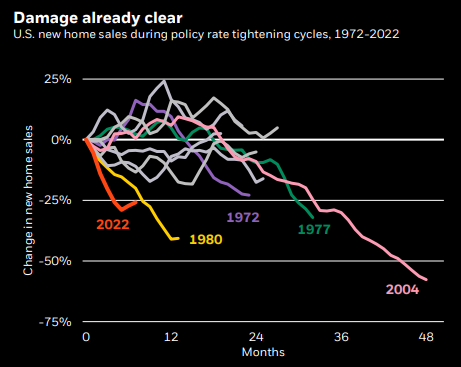 CHART: RIGHT — The degree of damage from the RATE of Fed Rate hike increases is a clear warning of what still lies ahead. The slide in housing sales this year is already steeper than past mega Fed hiking cycles such as in the 1970’s and early 1980’s – as well as the unwind of the mid-2000’s US housing boom.
CHART: RIGHT — The degree of damage from the RATE of Fed Rate hike increases is a clear warning of what still lies ahead. The slide in housing sales this year is already steeper than past mega Fed hiking cycles such as in the 1970’s and early 1980’s – as well as the unwind of the mid-2000’s US housing boom.
To illustrate this we need to start with a view of Money Supply Growth as measured by US M2. We first compare its increase since the 2008 Financial Crisis against the increase in US GDP and the S&P 500 (first chart below).
MONEY GROWTH: A SERIOUS PROBLEM HIT BY AN UNEXPECTED EVENT
THE UNEXPECTED EVENT: COVID-19
The first chart shows a clear correlation between M2 Money Supply Growth and the growth in US GDP and the S&P 500 since the 2008 Financial Crisis. The yellow area highlights the significant surge following the precipitous drop in US GDP (& the corresponding drop in the S&P 500) as a result of Covid-19.
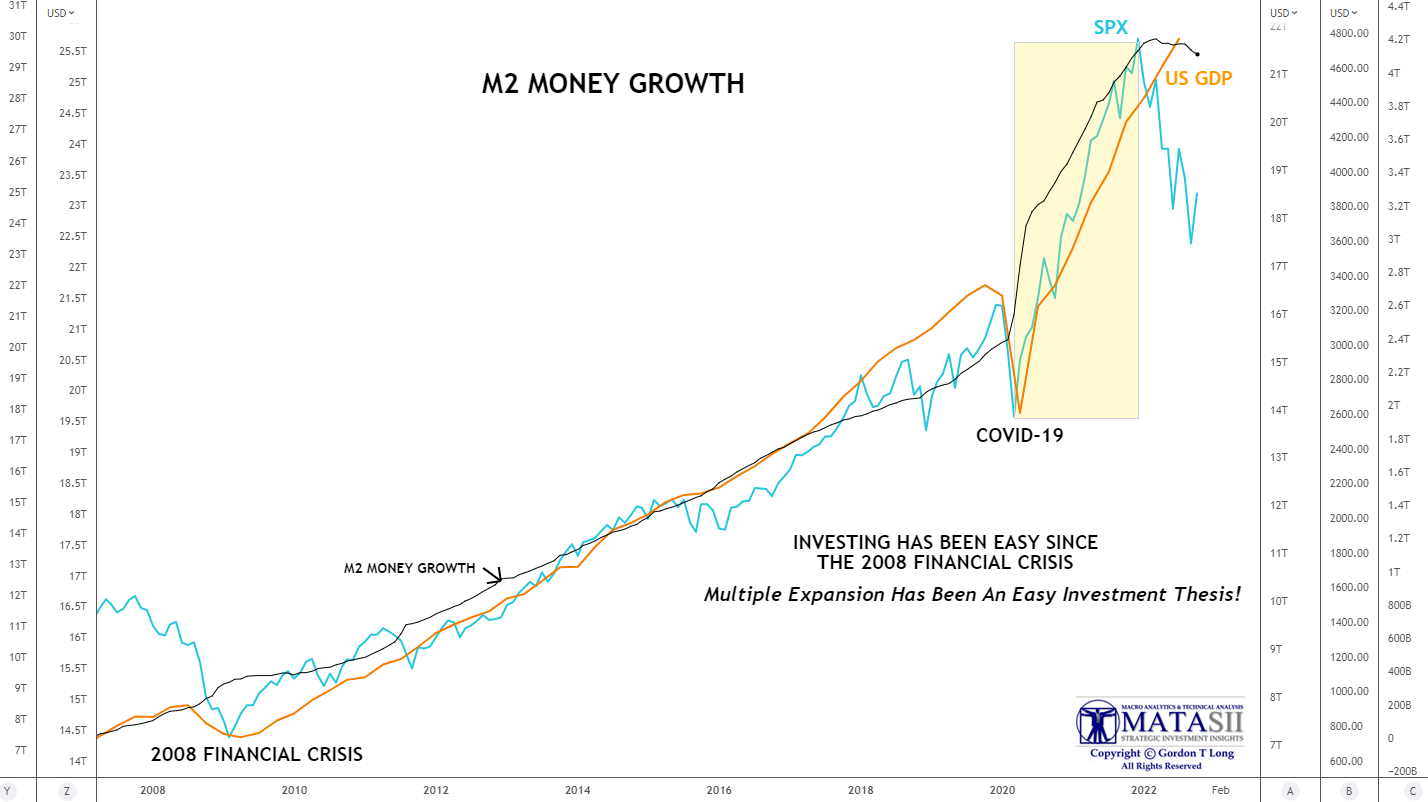
MONEY GROWTH: COVID-19 OVERPOWERED THE FED
THE PROBLEM : A DE-STABILIZING SHOCK
In the second chart we overlay the Federal Reserve’s balance sheet growth along with the change in reported US debt growth since the 2008 Financial Crisis. We see that’ though reported US debt growth continued to mirror the correlation above the Fed Balance sheet, growth was actually trending downward from the initiation of “TAPER” in 2014. This came to an abrupt halt and exploded upward to accommodate Covid-19 government recovery initiatives and supporting Fed Facilities.
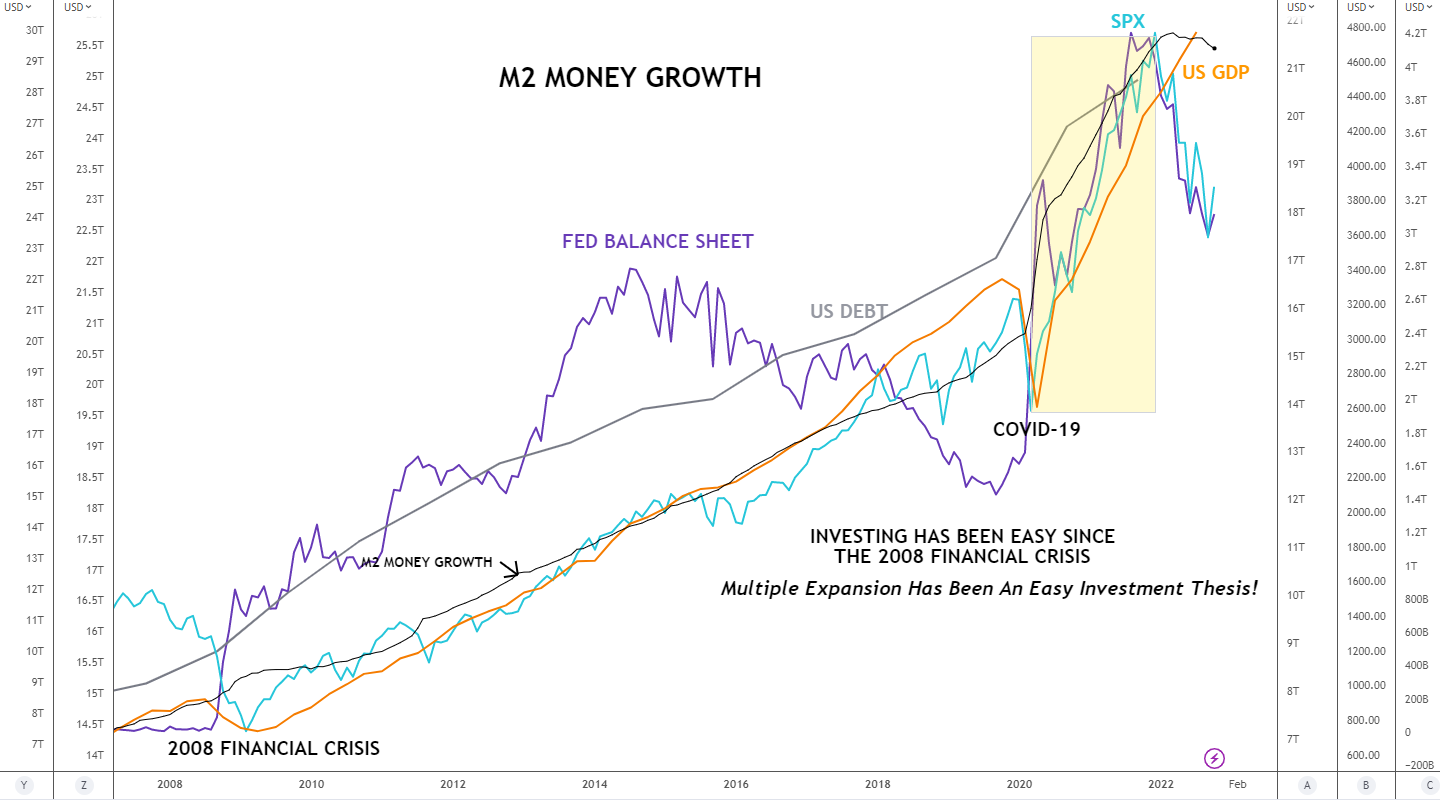
MONEY GROWTH: A DE-STABILIZING SHOCK!
THE RESULT : OBSCENE & IRRESPONSIBLE FISCAL SPENDNG
What the third chart overlays is the spending action taken during the yellow highlight period. Between $5 & $10 Trillion in spending was authorized. This included:
-
- The $1.9T American Rescue Plan expected to realistically involve $3.5T in spending,
- The $740b Inflation Reduction Act,
- The $1.2 Trillion Infrastructure Bill,
- The $280B CHIPS Bill,
- $650B Ukraine Military Support which currently is expected to soon approach $1 Trillion. This is money exploding into the US Military Industrial Complex across America.
As a direct result we had:
-
- An explosion in Wage pressures as Demand surged,
- Energy costs surged as a result of US Energy Policy abruptly reversed with the Biden administration, resulting in the US becoming a net importer of energy versus a net exporter,
- Dramatic rise in domestic food costs as a direct consequence of rising energy, fertilizer and input costs.
These factors together effectively amounted to a MASSIVE SHOCK to the system that is only now beginning to be played out!

GLOBAL SHOCK IMPACT
The result of this shock will be broad, but highlighted by:
-
- Increased market volatility, most critically in Bond and Credit markets resulting in higher risk duration premia for financing and equity risk premium pricing,.
- Financial Repression III – The emergence of the Regulatory State to better facilitate credit growth as unencumbered collateral shortages become an increasing problem,
- Growth of Regional Trading Blocs,
- A profound shift to “Near-Shorting”, increasing import barriers and slowing Globalization & trade.
2023 OUTLOOK
It is highly likely that the 2023 bottom up consensus earnings are materially too high. It is more inline with another 8% lower to $195 in the base case, a reflection of worsening output from our leading earnings models. This leaves16% below consensus on ’23 EPS and down 11% from a year-over-year growth standpoint. After what’s left of this current tactical rally, we see the S&P 500 discounting the ’23 earnings risk sometime in first half via a ~3,000-3,300 price trough. Our long held 3270 low on the S&P 500 is still valid.
We think this occurs in advance of the eventual trough in EPS, which is typical for earnings’ recessions. While we see 2023 as a very challenging year for earnings growth, 2024 should be a strong rebound where positive operating leverage returns—i.e., the next boom. Equities should begin to process that growth reacceleration well in advance and rebound sharply to finish the year at ~3,900.
Price leads earnings and it’s not typical to put a trough multiple on trough earnings. What this suggests is the Q1 price low is marked by a 13.5-15X multiple on a forward EPS number of ~$220.
13.5 X 220 = 2970
15.0 X 220 = 3300
A MORE BEARISH ALTERNATIVE ANALYSIS (Excerpted from a recently detailed analysis by Graham Summers)
When Treasuries were yielding 0.25%-0.4% throughout most of 2020 and 2021, investors were willing to pay 20-22 times forward earnings for stocks. However, once Treasury yields rose over 4% stocks were repriced down to 16-18 times forward earnings. This makes sense. When the “risk free” rate of return is close to zero, you’ll pay a premium for growth. But once you can earn 4+% “risk free” suddenly stocks look a lot riskier!
Indeed, stocks were priced at 20-22 times forward earnings for most of 2020 and 2021. However, once Treasury yields began to rise in late 2021, stocks peaked in terms of multiples. They were eventually repriced down to 16-18 times earnings.
The ONLY thing that would stop stocks from being repriced lower would be if bond yields stabilized. The yield on the 2-Year U.S. Treasury now appears to have peaked.
Earnings are now collapsing, as the economy collapses into a severe recession. This means the denominator in the P/E ratio (Price/ Earnings) is now shrinking. Earnings for the third quarter of 2022 are DOWN 8% Y-o-Y. As Charlie Bilello notes, this is the second consecutive quarter of negative earnings growth on a Year over Year basis.
Unfortunately, earnings will be dropping even more going forward. To understand why, we need to first understand the Treasury market. The Treasury is comprised of numerous bonds with different maturation periods ranging from 4 weeks to 30 years. When you plot the yield on all of these bonds, you get the “yield curve.” And the difference in yield between various bonds on this curve is one of the most accurate predictors of recession. Specifically, the difference between the yield on the 10-Year U.S. Treasury and the yield on the 3-month U.S. Treasury.
Anytime this difference becomes negative (meaning the 3-month yield is actually higher than the 10-year yield) this indicates a recession is about to hit. The yield curve of the Treasury market is predicting a severe recession in the near future, likely the start of 2023. This is going to force stocks to new lows.
During the typical recession, Earnings Per Share (EPS) usually fall 25%. As I write this, Wall Street’s current consensus for 2023 EPS is $230. And Wall Street expects this to GROW by 5%!!! This means the anticipated fair value for the S&P 500 is somewhere between 3,680 and 4,140. Incidentally, that is the EXACT trading range the S&P 500 has been moving in for the last six months.
Put simply, the market is trading based on what Wall Street expects is coming down the pike. But as I just noted, Wall Street expects earnings growth of 5% next year. However, the reality is that bonds are telling us a recession is coming… and a recession would mean a DECLINE in earnings of at least 25% (remember, the yield curve is predicting a SEVERE recession).
This would mean the actual 2023 EPS would be closer to $172.
Assuming Treasury yields no longer rise, this means the fair value for the S&P 500 at 16 to 18 times this much lower EPS would be 2,752-3,096.
Historically, anytime the Fed stops tightening and begins easing:
- The markets don’t actually bottom for another 14 months.
- During the Tech Crash, the Fed started cutting rates in January of 2001. However, by that point, a recession had hit and stocks lost another 44% eventually bottoming in October 2003.
- Similarly, during the Housing Crash, the Fed started easing in August of 2007. There again, a recession hit and stocks lost another 56% before eventually bottoming in March 2009.
- Even if the Fed were to surprise everyone and start easing as soon as next month (December) the coming recession would STILL result in EPS collapsing and stocks cratering another 30% or so.
With stocks at 4,000 or so on the S&P 500, a 30% decline would bring them right to… 2,800, or around the lower end of the implied fair value for the market at a 16- times my expected EPS for 2023: $172.
Low Multiple Recessionary EPS Fair Value in 2023
16 X $172 = 2,752 or ~2.800
So again, this week we have both good news and bad news.
- The good news is that bonds are stabilizing.
- The bad news is that a recession is coming, and earnings are about to crater.
That will trigger a stock market collapse to new lows… possibly down to the mid-2000s on the S&P 500.
THE WORST IS STILL IN FRONT OF US THROUGH TO THE BEGINNING OF Q1 2023.
FADE THE COUNTER RALLY – SELL THE RIPS.
HOLD LONG DATED TREASURIES
IN Q2-Q3 2023, EXPECT TO BUY EQUITIES & SELL TREASURIES.
THE US TREASURY PRICE CONSOLIDATION TRIANGLE IS
NEARING COMPLETION.
NOTE: An ISLAND PATTERN is a high probability pattern and a major Intermediate Term reversal signal.
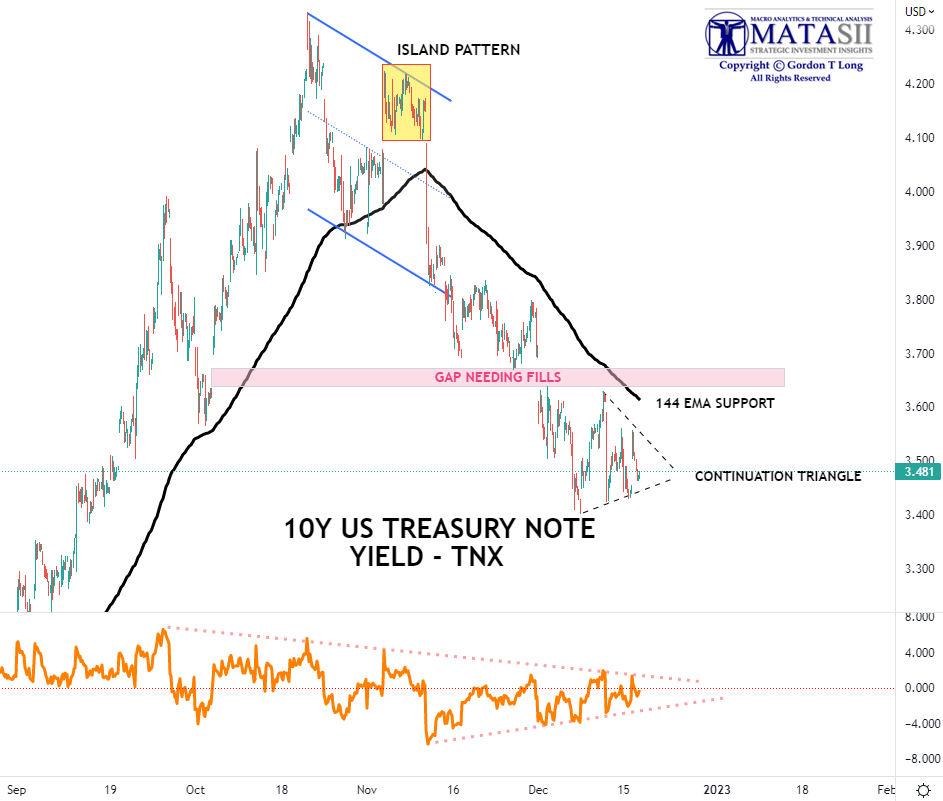
YOUR DESK TOP / TABLET / PHONE ANNOTATED CHART
Macro Analytics Chart: SUBSCRIBER LINK
FAIR USE NOTICE This site contains copyrighted material the use of which has not always been specifically authorized by the copyright owner. We are making such material available in our efforts to advance understanding of environmental, political, human rights, economic, democracy, scientific, and social justice issues, etc. We believe this constitutes a ‘fair use’ of any such copyrighted material as provided for in section 107 of the US Copyright Law. In accordance with Title 17 U.S.C. Section 107, the material on this site is distributed without profit to those who have expressed a prior interest in receiving the included information for research and educational purposes. If you wish to use copyrighted material from this site for purposes of your own that go beyond ‘fair use’, you must obtain permission from the copyright owner.
NOTICE Information on these pages contains forward-looking statements that involve risks and uncertainties. Markets and instruments profiled on this page are for informational purposes only and should not in any way come across as a recommendation to buy or sell in these assets. You should do your own thorough research before making any investment decisions. MATASII.com does not in any way guarantee that this information is free from mistakes, errors, or material misstatements. It also does not guarantee that this information is of a timely nature. Investing in Open Markets involves a great deal of risk, including the loss of all or a portion of your investment, as well as emotional distress. All risks, losses and costs associated with investing, including total loss of principal, are your responsibility.


